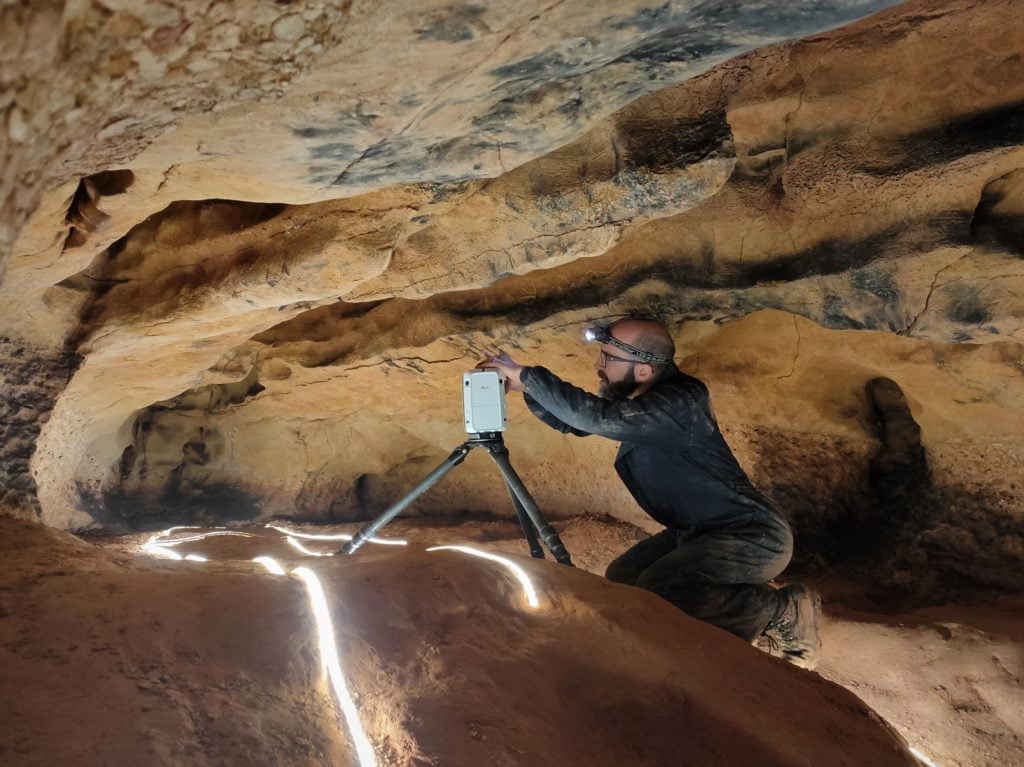Welcome to DU!
The truly grassroots left-of-center political community where regular people, not algorithms, drive the discussions and set the standards.
Join the community:
Create a free account
Support DU (and get rid of ads!):
Become a Star Member
Latest Breaking News
General Discussion
The DU Lounge
All Forums
Issue Forums
Culture Forums
Alliance Forums
Region Forums
Support Forums
Help & Search
Anthropology
Related: About this forumExperts Discover a 'Shrine' of 15,000-Year-Old Animal Carvings and Mysterious Symbols in a Spanish C
The astounding carvings includes depictions of horses and bulls as well as mysterious abstract symbols.
Javier Pes, February 17, 2020

Archaeologist makes a 3D scan of the prehistoric cave art at Font Major. Photo courtesy of IPHES.
Experts have discovered a cave full of prehistoric carvings in northern Spain. Among the hundreds of rock carvings, some believed to be 15,000 years old, are vivid depictions of horses, deer, and bulls, as well as a wealth of mysterious and abstract symbols. Unlike the famous prehistoric paintings at Altamira, also in northern Spain, the recently discovered cave art in Catalonia is carved directly into the soft surface of the rock.
A team of archaeologists stumbled across the richly decorated cave at the end of October, although their discoveries have only just been announced. Josep Maria Vergès, who led the team from IPHES (the Catalan Institute of Human Palaeoecology and Social Evolution) described the find as “exceptional” in a statement, and compared the cave to a “shrine.”
The cave art is now being recorded and studied using 3D scanning technology. The engravings were created on a layer of soft sand deposited on the cave’s surface in an area that is difficult to access. The artworks are extremely fragile and can be damaged if touched; several figures seem to have been damaged in the past by visitors who were unaware of their existence. Experts are now studying the best way to preserve the remarkable finds.
Vergès tells Artnet News, that he felt a “mixture of surprise and disbelief, followed by great satisfaction,” when the he first saw the ancient works of art. “Surprise because the cave is not an ideal place to find engravings due to the characteristics of the rock, the walls were very irregular, and the specialists thought that it was not suitable for painting or engraving.” He says it seemed impossible that none of the thousands of people who have passed through the cave’s gallery in the past has ever spotted that “between and under the modern inscriptions there were tens of Paleolithic engravings.”
More:
https://news.artnet.com/art-world/prehistoric-cave-art-animals-1779519
InfoView thread info, including edit history
TrashPut this thread in your Trash Can (My DU » Trash Can)
BookmarkAdd this thread to your Bookmarks (My DU » Bookmarks)
6 replies, 3908 views
ShareGet links to this post and/or share on social media
AlertAlert this post for a rule violation
PowersThere are no powers you can use on this post
EditCannot edit other people's posts
ReplyReply to this post
EditCannot edit other people's posts
Rec (44)
ReplyReply to this post
6 replies
 = new reply since forum marked as read
Highlight:
NoneDon't highlight anything
5 newestHighlight 5 most recent replies
= new reply since forum marked as read
Highlight:
NoneDon't highlight anything
5 newestHighlight 5 most recent replies
Experts Discover a 'Shrine' of 15,000-Year-Old Animal Carvings and Mysterious Symbols in a Spanish C (Original Post)
Judi Lynn
Feb 2020
OP
Argh!!! The link isn't coming thru for me...will try later when its mood has improved.❤
Karadeniz
Feb 2020
#1
Karadeniz
(22,475 posts)1. Argh!!! The link isn't coming thru for me...will try later when its mood has improved.❤
Nitram
(22,768 posts)2. Some good photos of the art at the link.
lunatica
(53,410 posts)3. As an artist I believe ancient cave art and rock art
like in Australia, France, Spain, and the Americas were about the effort to capture the spirit, the essence of the objects depicted. It was basically a practicing of magic. Of a bringing forth the things the people needed to survive. It was serious survival business. Not play.
Even today viewers who talk about portraiture are always talking about artists capturing the ‘essence’ of the particular subject. And, of course, it is the singular objective of most artists.
2naSalit
(86,378 posts)4. You have to sign up at the web site
and can't see the article or pictures unless you do. ![]()
billh58
(6,635 posts)5. I clicked the link,
and got in immediately with complete access to the article and the pics. I think it may be a browser thing (I'm using Chrome).
burrowowl
(17,632 posts)6. Thanks for link!